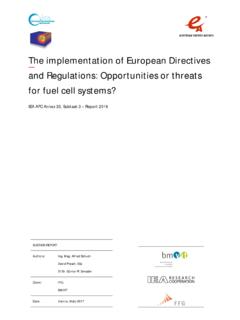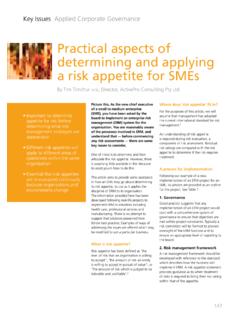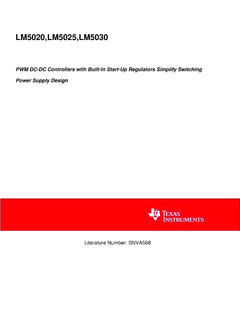Transcription of THE YELLOW PAGES OF SOFC TECHNOLOGY - …
1 DOSSIERTHE YELLOW PAGES OF SOFC TECHNOLOGYI nternational Status of SOFC deployment2012-2013 Stephen J. McPhail, Luigi Leto, Carlos Boigues-Mu ozIEAI mplementing AgreementAdvanced Fuel CellsAnnex 24 SOFCIMP COPERTINA DOSSIER inglese 13-05-2013 10:44 Pagina 1 THE YELLOW PAGES OF SOFC TECHNOLOGY International Status of SOFC deployment 2012-2013 IEA - implementing Agreement Advanced Fuel Cells Annex 24 SOFC Stephen J. McPhail, Luigi Leto, Carlos Boigues-Mu oz 2013 ENEA National Agency for New Technologies, Energy and Sustainable Economic Development Lungotevere Thaon di Revel, 76 00196 Rome ISBN 978-88-8286-290-9 Cover images courtesy of SOFC power and Kerafol 3 TABLE OF CONTENTS THE SOFC BASIC PRINCIPLES.
2 5 High efficiency .. 5 Fuel flexibility .. 6 Insignificant emissions .. 6 Silent operation .. 6 How it works .. 7 APPLICATION AREAS .. 8 Mobile, military and strategic .. 8 Auxiliary Power Units (APU) (1-250 kW) .. 9 Stationary small scale combined heat and power (m-CHP) .. 11 Stationary medium-large scale .. 12 A WORLD INDUSTRY: Overview of worldwide SOFC developers .. 13 North America .. 13 Acumentrics .. 13 Bloom Energy .. 14 Delphi .. 16 LG Fuel Cell Systems (LGFCS) .. 17 Protonex .. 19 Ultra Electronics AMI .. 20 Lockheed Martin .. 20 Versa Power Systems .. 21 Europe .. 24 Ceres Power .. 24 Elcogen .. 25 Hexis AG .. 26 SOFC power SpA .. 28 4 Staxera-Sunfire.
3 29 Tops e Fuel Cell .. 30 Convion/W rtsil .. 31 Japan .. 32 Kyocera .. 32 Mitsubishi Heavy Industries (MHI) .. 34 Australia .. 36 Ceramic Fuel Cells Limited (CFCL) .. 36 IEA implementing Agreement Advanced Fuel Cells ANNEX 24 SOFC 5 THE SOFC BASIC PRINCIPLES Solid oxide fuel cells (SOFC) are a cutting-edge TECHNOLOGY for converting the chemical energy in hydro-carbon fuels to electrical power and heat by means of an electrochemical reaction. SOFC TECHNOLOGY has many advantages over conventional power trains, such as combustion engines, including: high efficiency, including at small scale fuel flexibility insignificant NOx, SOx and particulate emissions, reduced CO2 emissions silent and vibration-free operation.
4 High efficiency The SOFC differs from conventional technologies such as combustion engines and gas turbines in that it converts the chemical energy of fuels electrochemically, generating electrical power directly, avoiding the inefficient steps of combustion and transformation of heat to mechanical work in order to drive the electrical generator. Efficiency, %Power installed, MWSOFC-GTSteam TurbineDiesel EngineGas EngineGTCCICEPAF CPEFC 1 10 10080607050403020100 MicroturbineIGCCSOFCMCFC Figure 1. Comparison of combustion-based system and fuel cell efficiencies vs.
5 Power installed (ICE = internal combustion engine, GTCC = gas-steam turbine combined cycle, IGCC = integrated gasification combined cycle, PEFC = polymer electrolyte fuel cell, PAFC = phosphoric acid fuel cell, MCFC = molten carbonate fuel cell, SOFC = solid oxide fuel cell, SOFC-GT = SOFC and gas turbine bottoming cycle). [source: ENEA, ] Ideally, the power produced in an SOFC can reach up to 70% of the inlet fuel energy; in practice, within an end-user-ready system, these efficiencies are between 40-60%, depending on the power plant con-figuration. Combustion-based technologies can only reach 55% electrical efficiency in very large-scale power plants (of hundreds or thousands of Megawatts).
6 The SOFC efficiency is unique in being practi-cally independent of scale, and systems have been demonstrated with 60% net efficiency even at one kilowatt of delivered power. IEA implementing Agreement Advanced Fuel Cells ANNEX 24 SOFC 6 Fuel flexibility Thanks to the SOFC s high operating temperature (600-900 C), low molecular weight hydrocarbons can be internally reformed, without the need for an external reformer. With appropriate conditioning, in order to remove harmful contaminants and to ensure a proper balance of the specific carbon com-pounds, such diverse fuels can be utilized as natural gas, biogas, ethanol, methanol, propane, LPG (liq-uefied petroleum gas) and even diesel and jet fuel.
7 Alternative carbon-free liquid fuels such as ammonia and hydrazine can also be utilized in SOFCs, even though the use of the latter remains limited due to its high production cost. Ammonia, used to great extent in industry for the synthesis of fertilizers and explosives, presents the advantages of being low-cost, simple to store, containing high energy density without production of carbon dioxide. Insignificant emissions By avoiding a combustion process to convert fuel to electricity, the SOFC does not produce nitrous ox-ides (NOx) or fine particulate matter. Furthermore, because sulphur compounds are poisonous for the fuel cell, they need to be extracted from the fuel beforehand to ensure reliable operation, therefore sulphurous oxide (SOx) emissions are insignificant.
8 In this way it is also guaranteed that no harmful compounds are released into the environment, shifting the onus of emission control onto the fuel sup-plier, where it can be handled efficiently and centrally. Thanks to the SOFC s high efficiency, for a given amount of power produced less primary fuel is re-quired, which means less CO2 is emitted to the atmosphere. If the fuel is obtained from renewable sources, such as biogas, the operation of the SOFC is effectively carbon-neutral, and ultra-clean. Figure 2. Comparison of CO2 emissions between combustion-based systems and a natural gas-fed SOFC. [source: Acumentrics, ] Silent operation Electrochemical conversion of the fuel forsakes the need for moving parts for power generation, which means an SOFC system runs essentially vibration- and noise-free: a desirable characteristic both in open spac-es and closed areas.
9 Figure and vibration emissions from a small FC system may reach so low levels that you may not heard it while you talk. [source: Protonex, ] IEA implementing Agreement Advanced Fuel Cells ANNEX 24 SOFC 7 How it works In Figure 4 below, the building block of the SOFC is shown: each of these cells consisting of an anode, electrolyte and cathode can be connected and stacked up to provide any requirement of power. This modular build-up is what makes it possible for the SOFC to have practically constant efficiencies from Megawatt to single watt scale. The fuel is fed to the anode side, where the high temperature allows it to be separated into its essential constituents.
10 In hydrocarbons, these are hydrogen (H2) and carbon monoxide (CO). H2 and CO react in the same way at the anode. Taking H2 as an example, it reacts electrochemically to generate two elec-trons per molecule of hydrogen. This current is made to flow across the electrical load that needs to be powered, and reacts at the cathode side with the air or the oxygen (O2) in particular that is fed there. Every two electrons generate an oxygen ion (O2-), which migrates across the gas-tight electrolyte to the anode, where it reacts with the hydrogen to release again the two electrons that generated the O2- ion, effectively closing the circuit.









